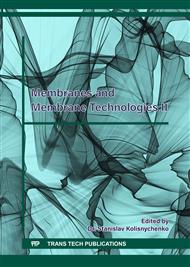[1]
A. Rahimpour, M. Jahanshahi, S. Khalili, A. Mollahosseini, A. Zirepour, B. Rajaeian, Novel functionalized carbon nanotubes for improving the surface properties and performance of polyethersulfone (PES) membrane, Desalination 286 (2012) 99–107.
DOI: 10.1016/j.desal.2011.10.039
Google Scholar
[2]
Q. Shi, Y. Su, S. Zhu, C. Li, Y. Zhao, Z. Jiang, A facile method for synthesis of pegylated polyethersulfone and its application in fabrication of antifouling ultrafiltration membrane, J. Membr. Sci. 303 (2007) 204–212.
DOI: 10.1016/j.memsci.2007.07.009
Google Scholar
[3]
H. Wang, L. Yang, X. Zhao, T. Yu, Q. Du, Improvement of hydrophilicity and blood compatibility on polyethersulfone membrane by blending sulfonated polyethersulfone, Chin. J. Chem. Eng. 17 (2009) 324–329.
DOI: 10.1016/s1004-9541(08)60211-6
Google Scholar
[4]
B. K. Chaturvedi, A. K. Ghosh, V. Ramachandhran, M. K. Trivedi, M. S. Hanra and B. M. Misra, Preparation, characterization and performance of polyethersulfone ultrafiltration membranes, Desalination. 133(1) (2001) 31-40.
DOI: 10.1016/s0011-9164(01)00080-7
Google Scholar
[5]
R. M. Boom, I. M. Wienk, T. van den Boomgaard and C. A. Smolders, Microstructures in phase inversion membranes. Part 2. The role of a polymeric additive, J. Membrane Sci. 73(2) (1992) 277-292.
DOI: 10.1016/0376-7388(92)80135-7
Google Scholar
[6]
P. S. T. Machado, A. C. Habert and C. P. Borges, Membrane formation mechanism based on precipitation kinetics and membrane morphology: flat and hollow fiber polysulfone membranes, J. Membrane Sci. 155(2) (1999) 171-183.
DOI: 10.1016/s0376-7388(98)00266-x
Google Scholar
[7]
M. Ulbricht, M. Riedel and U. Marx, Novel photochemical surface functionalization of polysulfone ultrafiltration membranes for covalent immobilization of biomolecules, J. Membrane Sci. 120(2) (1996) 239-259.
DOI: 10.1016/0376-7388(96)00148-2
Google Scholar
[8]
D. S. Wavhal and E. R. Fisher, Hydrophilic modification of polyethersulfone membranes by low temperature plasma-induced graft polymerization, J. Membrane Sci. 209(1) (2002) 255-269.
DOI: 10.1016/s0376-7388(02)00352-6
Google Scholar
[9]
A. Nabe, E. Staude and G. Belfort, Surface modification of polysulfone ultrafiltration membranes and fouling by BSA solutions, J. Membrane Sci. 133(1) (1997) 57-72.
DOI: 10.1016/s0376-7388(97)00073-2
Google Scholar
[10]
Information on https://omnexus.specialchem.com/selection-guide/polyethersulfone-pes-thermoplastic.
Google Scholar
[11]
S. Saeidlou, M. A. Huneault, H. Li and C. B. Park, Poly(lactic acid) crystallization, Prog. Polym. Sci. 37(12) (2012) 1657-1677.
DOI: 10.1016/j.progpolymsci.2012.07.005
Google Scholar
[12]
H. Susanto and M. Ulbricht, Characteristics, performance and stability of polyethersulfone ultrafiltration membranes prepared by phase separation method using different macromolecular additives, J. Membrane Sci. 327(1-2) (2009) 125-135.
DOI: 10.1016/j.memsci.2008.11.025
Google Scholar
[13]
J. F. Li, Z. L. Xu, H. Yang, C. P. Feng, J. H. Shi, Hydrophilic Microporous PES Membranes Prepared byPES/PEG/DMAc Casting Solutions, J. Appl. Polym. Sci. 107 (2008), 4100–4108.
DOI: 10.1002/app.27626
Google Scholar
[14]
Information on https://imagej.nih.gov/ij/.
Google Scholar
[15]
G. Demirel, T.Caykara, M. Demiray and M. Gürü, Effect of Pore-Forming Agent Type on Swelling Properties of Macroporous Poly(N-[3-(dimethylaminopropyl)]-methacrylamide-co-acrylamide) Hydrogels, J. Macromol. Sci. A. 46(1) (2008) 58-64.
DOI: 10.1080/10601320802515316
Google Scholar
[16]
J. Chen, J. Li, X. Zhan, X. Han and C. Chen, Effect of PEG additives on properties and morphologies of polyetherimide membranes prepared by phase inversion, Front. Chem. Eng. China. 4(3) (2010) 300–306.
DOI: 10.1007/s11705-009-0280-8
Google Scholar



